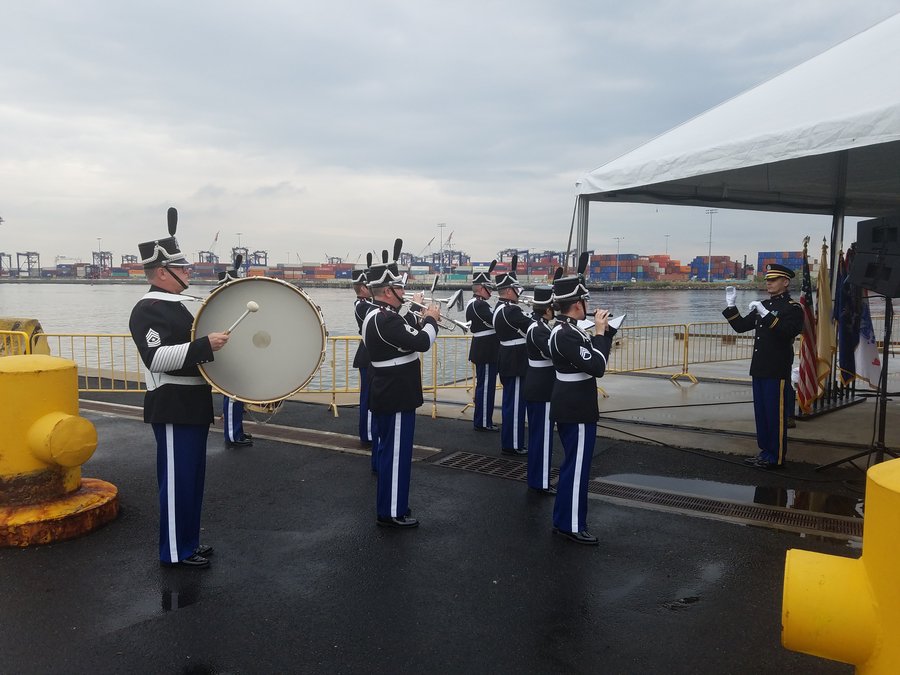Officials from the U.S. Army Corps of Engineers, the Port Authority of New York and New Jersey, and lawmakers came together for a ceremony at Cape Liberty in Bayonne on Thursday, September 1 to celebrate the completion of the $2.1 billion Main Navigation Channel Deepening Program, which started in 2004 and deepened the harbor by 50 feet to allow for larger ships to access the terminals at Port Newark, GCT Bayonne, and the Howland Hook Marine Terminal.
The project comes after the Panama Canal celebrated its expansion in June, adding a new lane allowing for more traffic and Neo-Panamax ships to pass through, which have drafts of 48 feet or more and can carry twice as much cargo as the previous Panamax ships. Now, those ships can access the Port of New York and New Jersey.
The deepened harbor surrounds most of the peninsula of Bayonne, including the Kill Van Kull and Arthur Kill Channel to the south, the Port Channel and Anchorage Channel to the east, and the Newark Bay Channel to Port Elizabeth and Port Newark to the west. The deeper channel also extends into the Ambrose Channel under the Verrazano Bridge and into the Atlantic.
The celebration
Mayor James Davis was one of the first to speak. “On my part, and on behalf of my city, I am proud to say that because of projects like this Bayonne remains a gateway for commerce at the Port of New York and New Jersey, one of the most productive port operations in the world,” he said. “Today should serve as a reminder to all of us that we should always push the limits of what we believe can be accomplished. It is not to say that there won’t be challenges along the way, but it is important that we press onward for the greater good.”
Councilman-at-large Juan Perez was also on hand. “This is fantastic for the economy in Bayonne,” he said. “This is going to stimulate jobs. It’s great. Everything is positive.”
All about the economy
“This is an incredibly important day for the country and our economy more broadly,” said Jacob Broder-Fingert, Senior Policy Advisor on the White House Economic Council. He cited the country’s slow, but steady economic progress since the 2008 financial crisis, noting a 47-percent increase in exports since 2010 and “roughly 12 million jobs” being supported by that economic activity. “It’s evidence as you look at the export numbers that the rest of the world wants what we make here in America … and the deepened port and bigger ships will allow us to do more exporting and allow our country to continue to grow.”
Supplying the nation’s most populated region, the Port of New York and New Jersey is the largest on the East Coast, and the third in the nation, behind the ports in Los Angeles and Long Beach. Senator Bob Menendez lauded the project for protecting 336,000 port jobs in the region, as well as businesses all along the East Coast. “It will ensure that area businesses have easier and more affordable access to global markets, particularly now with the completion of the Panama Canal expansion, and improve the shipping of goods to nearly 100 million American consumers living on the East Coast,” he said.
Other speakers and attendees included U.S. Representative Rodney Frelinghuysen (N.J.-11); U.S. Representative Albio Sires (N.J.-08); U.S. Representative Donald Payne, Jr. (N.J.-10); U.S. Representative Daniel Donovan (N.Y.-11); New Jersey Lt. Gov. Kim Guadagno; Colonel David Caldwell of the U.S. Army Corps of Engineers; and Director of Port Commerce Molly Campbell of the Port Authority.
Fifty-two million cubic yards of dredged silt, sands, glacial deposits, such as till and clay, as well as six kinds of bedrock were unearthed from the harbor’s basin, some of which was given out as souvenirs at the end of the ceremony. The rest was used to create fishing reefs from blasted rock, restore marshes, remediate existing landfills and brownfields in the region, and cap the Historic Area Remediation Site off the New Jersey coast.
Side note on the TPP
Broder-Fingert also used the occasion to promote the Trans-Pacific-Trade-Partnership (TPP). “This project is a great reminder of why we need to continue to push for the TPP,” he said. “There are a lot of stakeholders here who really came together … and took the President’s call to action and got the project done. It’s great to see it get over the finish line.”
The TPP has been a point of controversy in the presidential elections with both candidates blaming trade agreements for the loss of jobs in the U.S., while others argue that a trade agreement opens the door for new labor markets and makes goods more accessible and affordable. TPP has been negotiated but not yet ratified. It involves 12 countries that are responsible for 40 percent of global GDP, according to the U.S. Department of Commerce: the U.S., Japan, Malaysia, Vietnam, Singapore, Brunei, Australia, New Zealand, Canada, Mexico, Chile, and Peru. Bayonne is at the geographic heart of U.S. trade with these countries. The U.S. seeks to cut trade tariffs and strengthen economic ties among the countries.
Rory Pasquariello may be reached at roryp@hudsonreporter.com.
